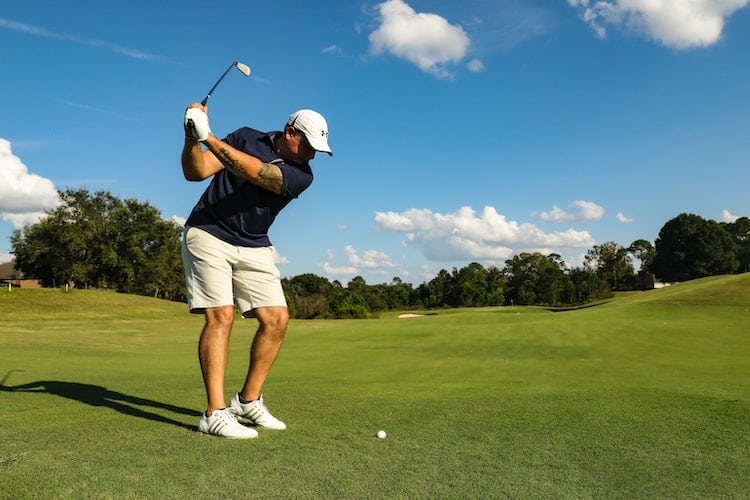
Are you constantly hitting a snap hook off the tee?
Do your iron shots miss to the left also?
If so, you may be suffering the effects of a left hand golf grip that is too strong.
If your left hand is gripping the golf club too strong, it can cause issues with your golf game. Learn more about what causes this problem and how to fix it. Having a good grip is essential if you want to improve as a golfer.
What is a Strong Left Handed Golf Grip?
There is an easy way to tell if you have a strong left handed golf grip. Take your normal grip on the golf club and line up like you are about to take a full golf swing. While in the address position, count how many knuckles you can see on your left hand.
If you can see three knuckles or more on your left hand, you have a strong left hand golf grip. Beginner golfers are often taught by golf instructors to employ a strong left hand grip with the hopes that it will help them avoid a slice. To make a strong left-hand grip work, the golfer must use a ton of body rotation.
How a Strong Left Hand Grip Can be Problematic
Though there are several pro golfers on the PGA Tour that use a strong left hand grip, it won’t work well for the majority of beginner golfers. Here is why a strong left hand grip can be problematic.
1. It Can Cause Golfers to Hook the Golf Ball
Probably the most common problem of using a left hand grip that is too strong is hooking the ball. Why does this happen?
When a strong grip is used, the left wrist often snaps the clubface shut just before making contact with the golf ball. This causes the ball to go left most of the time and results in inaccurate shots and lots of frustration.
2. Lower Ball Flight
Golfers who prefer stronger grips often hit the ball much lower than folks who use a neutral grip or a weak grip. This happens because a strong grip delofts the golf club, which naturally causes a much lower ball flight.
A lower ball flight may not sound like that big of a deal, especially when talking about the larger golf clubs like the driver and fairway woods. However, a lower ball flight can impede a golfer’s ability to hit accurate iron shots. This is especially true with the wedge shots that are close to the green.
3. Short Game Problems
Another huge problem that a strong golf grip can cause has to do with the golfer’s short game. Many golfers who use a strong left hand grip have a hard time hitting accurate chip and pitch shots. It’s tough to generate enough spin on all short game shots when using a strong grip.
As with a full golf swing, the wrist position with a strong grip delofts the club. This makes it difficult to hit any type of high chip shot. A strong grip also makes the clubface harder to control which is very detrimental to the short game.
How to Fix It
If you are hitting the golf ball just fine with a strong left hand grip and shooting low scores, don’t mess with what you are doing. There is no reason to fix something that is working well for you.
However, if you’re fighting a hook, hitting the ball too low, or struggling with your chipping, here’s how to fix your grip.
1. Put the Left-Hand Knuckles in Neutral Position
Instead of having three or more knuckles on the left hand visible at address, try weakening your grip slightly so that only two knuckles can be seen. If you can see two to two and a half knuckles at address, this is a neutral left-hand grip, which is our goal.
With a strong left hand grip, you won’t be able to see your left thumb because it is tucked on the other side of the shaft. However, with a neutral left-hand grip, you should be able to see your left thumb.
2. Use the Correct Right-Hand Grip
Instead of seeing no knuckles on the right hand like with a strong grip, you should see one or one and a half knuckles when moving to a neutral grip. This will make it much easier to use either an interlocking grip or an overlap grip style.
3. Check the V’s
When working on a grip change, it’s vitally important to check which way your V’s are pointing. Not sure what we mean by V’s?
When gripping the golf club, each index finger and thumb form a V shape. If your hands are in a truly neutral position, the V of both hands will point at your right shoulder.
4. Practice, Practice, PRACTICE!
Undergoing a grip change is a tremendous challenge, especially if you have been using the same type of grip for years. The best way to get comfortable with a new grip is to spend more time at the driving range.
PGA Tour legends like Ben Hogan, Jack Nicklaus, and Tiger Woods all went through grip changes at various points in their illustrious careers. You can bet they each spent countless hours on the practice range while getting used to their new grip.

